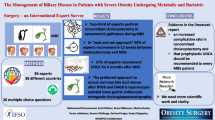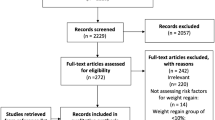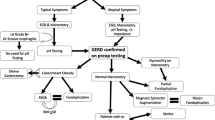Abstract
Background
Dumping syndrome is a well-known side effect of laparoscopic gastric bypass (LRYGB), and it is commonly believed that dumping syndrome is less likely to occur after laparoscopic sleeve gastrectomy (LSG), due to the preservation of the pyloric sphincter. However, it is not uncommon for patients undergoing LSG at our center to report symptoms suggestive of dumping syndrome.
Objective
To assess the prevalence of symptoms of dumping syndrome after LSG compared with LRYGB.
Setting
A single surgical group at a high-volume (700 cases per year) Bariatric and Metabolic Surgery Center of Excellence.
Methods
One thousand four hundred seventy-one LRYGB (366) and LSG (1105) patients received a questionnaire to assess symptoms of dumping syndrome, utilizing a modified version of the Sigstad scoring system. Dumping syndrome was considered to be present when the questionnaire score exceeded a threshold value.
Results
A total of 360 responses were received (249 LSG, 111 LRYGB). 26.5% (66) LSG and 41.4% (46) LRYGB exceeded the threshold for dumping syndrome (p < 0.01). 84.8% (56) LSG and 84.7% (39) LRYGB reported early dumping syndrome (p > 0.05). Thirty-six percent (24) LSG and 28% (13) LRYGB reported late dumping syndrome (p > 0.05). Twenty-seven percent (62) LSG and 44.4% (44) LRYGB reported at least one symptom of dumping syndrome with sweets (p < 0.05). 34.3% (85) LSG and 35.5% (39) LRYGB reported symptoms when drinking with or within 30 min of a meal (p > 0.05). 14.5% (36) LSG and 17.3% (19) LRYGB reported symptoms after alcohol consumption (p > 0.05).
Conclusion
Dumping syndrome after LSG is prevalent but has not been widely reported. This finding may impact clinicians and patients in their choice of procedure and has relevance in post-operative education and care.


Similar content being viewed by others
References
Ibrahim AM, Ghaferi AA, Thumma JR, et al. Variation in outcomes at bariatric surgery centers of excellence. JAMA Surg. 2017;152(7):629–36.
Miholic J, Orskov C, HOLST JJ, et al. Emptying the gastric substitute, glucagon-like peptide-1 (GLP-1), and reactive hypoglycemia after total gastrectomy. Dig Dis Sci. 1991;36(10):1361–70.
Roslin MS. Why it matters. A paired editorial for “Hypoglycemia after Roux-en-Y gastric bypass: detection rates of continuous glucose monitoring (CGM) versus mixed meal test.”. Surg Obes Relat Dis. 2015;11(3):569–72.
Tzovaras G, Papamargaritis D, Sioka E, et al. Symptoms suggestive of dumping syndrome after provocation in patients after laparoscopic sleeve gastrectomy. Obes Surg. 2012;22:23–8.
Ramadan M, Loureiro M, Laughlan K, et al. Risk of dumping syndrome after sleeve gastrecomy and roux-en-y gastric bypass: early results of a multicentre prospective study. Gastroenterol Res Pract. 2016;2016:2570237.
Papamargaritis D, Koukoulis G, Sioka E. Dumping symptoms and incidence of hypoglycemia after provocation test at 6 and 12 months after laparoscopic sleeve gastrectomy. Obes Surg. 2012;22(10):1600–6.
Banerjee A, Ding Y, Mikami DJ, et al. The role of dumping syndrome in weight loss after gastric bypass surgery. Surg Endosc. 2013;27(5):1573–8.
Tack J, Arts J, Caenepeel P, et al. Pathophysiology, diagnosis and management of postoperative dumping syndrome. Nat Rev Gastroenterol Hepatol. 2009;6(10):583–90.
Ukleja A. Dumping syndrome: pathophysiology and treatment. Nutr Clin Pract. 2005;20(5):517–23.
Hepburn DA, Deary IJ, Frier BM. Symptoms of acute insulin-induced hypoglycemia in humans, with and without IDDM. Factor analysis approach. Diabetes Care. 1991;14(11):949–57.
NIH Conference. Gastrointestinal surgery for severe obesity Consensus Development Conference Panel. Ann Intern Med. 1991;115(12):956–61.
de Zwann M, Hilbert A, Swan-Kremeier L. Comprehensive interview assessment of eating behavior 18-25 months after gastric bypass surgery for morbid obesity. Surg Obes Relat Dis. 2010;6(1):79–85.
Kalarchian MA, Marcus MD, Courcoulas AP, et al. Self-report of gastrointestinal side effects after bariatric surgery. Surg Obes Relat Dis. 2014;10(6):1202–7.
Mallory GN, Macrgregor AM, Rand C. The influence of dumping on weight loss after gastric restrictive surgery for morbid obesity. Obes Surg. 1996;6(6):474–8.
Laurenius A, Olbers T, Naslund I. Dumping syndrome following gastric bypass: validation of the dumping syndrome rating scale. Obes Surg. 2013;17(11):740–55.
Nielsen JB, Pedersen AM, Gribsholt SB, et al. Prevalence, severity, and predictors of symptoms of dumping and hypoglycemia after Roux-en-Y gastric bypass. Surg Obes Relat Dis. 2016;12(8):1562–8.
Lee CJ, Clark JM, Schweitzer M, et al. Prevalence of and risk factors for hypoglycemic symptoms after gastric bypass and sleeve gastrectomy. Obes. 2015;23(5):1079–84.
Himpens J, Dapri G, Cadiere GB. A prospective randomized study between laparoscopic gastric banding and laparoscopic isolated sleeve gastrectomy: results after 1 and 3 years. Obes Surg. 2011;16:1450–6.
Kafri N, Valfer R, Nativ O, et al. Health behavior, food tolerance, and satisfaction after laparoscopic sleeve gastrectomy. Surg Obes Relat Dis. 2011;7:82–8.
Wilson-Perez HE, Chambers AP, Sandoval DA, et al. The effect of vertical sleeve gastrectomy on food choice in rats. Int J Obes. 2013;37(2):288–95.
Melissas J, Koukouraki S, Askoxylakis J, et al. Sleeve gastrectomy: a restrictive procedure? Obes Surg. 2007;17:57–62.
Melissas J, Daskalakis M, Koukouraki S, et al. Sleeve gastrectomy-a “food limiting” operation. Obes Surg. 2008;18:1251–6.
Braghetto I, Davanzo C, Korn O, et al. Scintigraphic evaluation of gastric emptying in obese patients submitted to sleeve gastrectomy compared to normal subjects. Obes Surg. 2009;19:1515–21.
Bernstine H, Tzioni-Yehoshua R, Groshar D, et al. Gastric emptying is not affected by sleeve gastrectomy – scintigraphic evaluation of gastric emptying after sleeve gastrectomy without removal of the gastric antrum. Obes Surg. 2009;19:293–8.
Mingrone G, Castagneto-Gissey L. Mechanisms of early improvement/resolution of type 2 diabetes after bariatric surgery. Diabetes Metab. 2009;35(6):518–23.
Csendes A, Braghetto I. Changes in the anatomy and physiology of the distal esophagus and stomach after sleeve gastrectomy. J Obes Weight Loss Ther. 2016;6(1)
Geer RJ, Richards WO, O’Diorisio TM, et al. Efficacy of octreotide acetate in treatment of severe postgastrectomy dumping syndrome. Ann Surg. 1990;212(6):678–87.
Arts J, Caenpeel P, Bisschops R, et al. Efficacy of the long-acting repeatable formulate of the somatostatin analogue octreotide in postoperative dumping. Clin Gastroenterol Hepatol. 2009;7:432–7.
Yun GW, Trumbo CW. Comparative response to a survey executed by post, mail, & web form. J Comput Mediat Commun. 2000;6(1):JCMC613.
Fincham JE. Response rates and responsiveness for surveys, standards, and the Journal. Am J Pharm Educ. 2008;72(2):43.
Ahmad A, Kornrich DB, Krasner H, et al. Oral Abstract Presentations, “Prevalence of dumping syndrome after laparoscopic sleeve gastrectomy and comparison with laparoscopic Roux-en-Y gastric bypass”. Surg Obes Relat Dis. 2017;13(2017):S7–S30.
Author information
Authors and Affiliations
Corresponding author
Ethics declarations
Conflict of Interest
The authors declare that they have no conflict of interest.
Ethical Approval
All procedures performed in studies involving human participants were in accordance with the ethical standards of the institutional and/or national research committee and with the 1964 Helsinki declaration and its later amendments or comparable ethical standards.
Informed Consent
Informed consent was obtained from all individual participants included in the study.
Additional information
Publisher’s Note
Springer Nature remains neutral with regard to jurisdictional claims in published maps and institutional affiliations.
Rights and permissions
About this article
Cite this article
Ahmad, A., Kornrich, D.B., Krasner, H. et al. Prevalence of Dumping Syndrome After Laparoscopic Sleeve Gastrectomy and Comparison with Laparoscopic Roux-en-Y Gastric Bypass. OBES SURG 29, 1506–1513 (2019). https://doi.org/10.1007/s11695-018-03699-y
Published:
Issue Date:
DOI: https://doi.org/10.1007/s11695-018-03699-y




